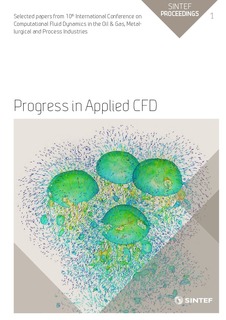| dc.contributor.author | Zaabout, Abdelghafour | |
| dc.contributor.author | Cloete, Schalk | |
| dc.contributor.author | Amini, Shahriar | |
| dc.date.accessioned | 2017-11-08T07:58:43Z | |
| dc.date.available | 2017-11-08T07:58:43Z | |
| dc.date.issued | 2015 | |
| dc.identifier.isbn | 978-82-536-1433-5 | |
| dc.identifier.isbn | 978-82-536-1432-8 | |
| dc.identifier.issn | 2387-4295 | |
| dc.identifier.uri | http://hdl.handle.net/11250/2464774 | |
| dc.description.abstract | This paper presents an investigation of the hydrodynamics of a new Chemical Looping Combustion (CLC) reactor concept for power generation with integrated CO2 capture. This concept consists of an internal circulating fluidized bed (IC-CLC) where a single reactor is divided into two separate sections in a way that oxidation and reduction of the oxygen carrier take place separately. Such a reactor configuration would significantly reduce the costs and solids handling challenges currently hampering the scale-up of CLC technology. Fundamental multiphase flow models (based on the Kinetic Theory of Granular Flow or KTGF) have been used to investigate the hydrodynamics in different reactor designs in order to identify the most optimized one which maintains minimized leakage between the two reactor sections. The performance of each design has been evaluated through a quantified parameter which is the volumetric gas/solid leakage ratio between the two reactor sections. Reactor designs with narrow connecting ports proved to be the most reliable in minimizing the gas leakage and therefore would maintain high CO2 purity and CO2 capture efficiency. The most optimized reactor design has then been selected for further investigation through a statistical method (central composite design) where the reactor performance response to the change in the bed loading and the air fluidization velocity has been evaluated. Values close to 1 were found for the fuel/solid leakage ratio parameter implying that high CO2 capture efficiency can be achieved through the chosen design in a wide range of bed loadings and fluidization velocities. In general, the reactor proved to perform best under conditions with high static bed heights and/or high fluidization velocities. | |
| dc.language.iso | eng | |
| dc.publisher | SINTEF Academic Press | |
| dc.relation.ispartof | Selected papers from 10th International Conference on Computational Fluid Dynamics in the Oil & Gas, Metallurgical and Process Industries | |
| dc.relation.ispartofseries | SINTEF Proceedings;1 | |
| dc.subject | Fluidized bed | |
| dc.subject | Chemical Looping Combustion | |
| dc.subject | Simulation-Based Reactor Design | |
| dc.title | Hydrodynamic investigation into a novel IC-CLC reactor concept for power production with integrated CO2 capture | |
| dc.type | Chapter | |
| dc.type | Conference object | |
| dc.type | Peer reviewed | |
| dc.description.version | publishedVersion | |
| dc.rights.holder | © 2015 SINTEF Academic Press | |
| dc.subject.nsi | VDP::Technology: 500 | |
| dc.identifier.cristin | 1233146 | |
